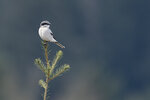



Introduction – In 2023 Liam Hutcheson located and documented 378 bird species in Washington, a new state record. I enjoyed hearing Liam tell the stories of his Big Year and I asked him to write about some of them for Birds of Thurston County. George Walter
For a dedicated birder, March in Washington is, on the surface, a relatively quiet month. It's a bridge between winter specialties and spring migration. But if you look carefully, you will see that things are really starting to happen in the bird world! Many of the earliest migrants, such as Violet-green, Tree, and Barn swallows, will show themselves in the first days of March, flying over the surfaces of ponds and wetlands with their aerobatic swoops and swirls. Rufous Hummingbirds will also be here soon, their distinctive buzzing trill brightening up the still, crisp air.
In the eastern half of our state, birds like Say’s Phoebe, Mountain Bluebird, Loggerhead Shrike, and Sagebrush Sparrows arrive at their breeding grounds on arid sagebrush steppe. Occasionally, some of these birds overshoot the Cascades and end up in Western Washington, including in and around Olympia. Last year was a great example of this, with Says Phoebe, Mountain Bluebird and Loggerhead Shrike all showing up in March.
Thurston County hosted at least one Say’s Phoebe in 2023 and a wayward flock of upwards of twenty Mountain Bluebirds at the Mima Mounds Natural Area Preserve. Mima Mounds also happened to attract a Loggerhead Shrike, one of the only records ever in Thurston. I was lucky enough to see all of these, boosting my Thurston life list over 220. At the time of writing this article (March 2024), there are multiple reports of Say’s Phoebe being seen in the Puget Sound lowlands, including the Nisqually Delta area. So, be on the lookout for this rare Western Washington species.
Say’s Phoebe is a relatively large flycatcher (larger than a Junco, smaller than a Robin). The overall color is gray to black, with a noticeable salmon-color wash on its belly, and it often pumps its tail. It hunts from an open perch, flying up to catch its prey and returning to the same perch. In many ways it looks in profile and behavior like a Black Phoebe, another uncommon species now being found locally.
Although March of 2023 was a relatively quiet month overall, I saw two vagrants that were essential birds for my big year. The first was a Laughing Gull, found by a fellow young birder at Tokeland on the southern Washington Coast. The Laughing Gull, an East Coast species, ended up spending the better part of the year in the Tokeland marina. Unlike most gulls, Laughing is actually rather distinctive and easily identified in all ages; this bird was a juvenile.
The second species I added was one I expected, but only really had one chance for – the Parakeet Auklet. The story of Parakeet Auklet is a very interesting one, as not long ago they would have been considered a rare vagrant anywhere in the lower 48. Parakeets nest in the Aleutian Islands of Alaska, and winter on the high seas of the North Pacific. Only in recent years have they been detected in numbers offshore of Washington, now that pelagic birders know what to look for. They, of course, likely have been out there all along but now winter pelagic birding trips are scheduled to see them.
However, seeing and identifying them for my big year was extremely tricky. They’re quite small; imagine seeing a softball sized brown bird bobbing up and down in between ocean swells. Also, Parakeets add to the difficulty with their annoying habit of diving when they see a boat, and they usually can see you much earlier than you'll ever see them. On occasion, they will wait a bit before diving, and that is when they are seen. I saw thirteen Parakeet Auklets on my pelagic birding day in March, including one photo that clearly showed the characteristic white streak behind the eye.
No one could achieve a significant Washington birding year list without going on one or more of the Westport Seabirds pelagic trips. They typically venture out 40 miles or so, seeking birds that seldom – if ever – come near shore. In 2023, one of these trips occurred in March, and as my first pelagic outing of the year, this was good for a number of other big-year birds. Although these were all common pelagic species birds that I would see more times through the year, I still enjoyed seeing them. On this March trip, I added Tufted Puffin, Ancient Murrelet, Cassin's Auklet, Sooty and Short-tailed Shearwater, Northern Fulmar, Black-footed Albatross, and Pomarine Jaeger to my growing big year list.
Today’s column was written by Liam Hutcheson, a student at Olympia’s Avanti High School who is an avid birder and accomplished bird photographer. Liam also provided the photographs.
Comments
No comments on this item Please log in to comment by clicking here